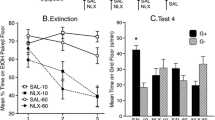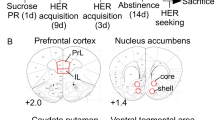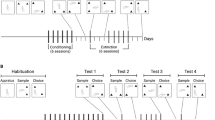Abstract
Rationale
The administration of heroin has been shown to inhibit the induction of nitric oxide, a molecule known to play a critical role in immune function. Previous research has shown that this alteration can be conditioned to environmental stimuli that have been associated with drug administration. However, it remains unknown whether the conditioned effects of heroin on nitric oxide formation follow accepted principles of learning.
Objective
This study sought to determine whether manipulations that induce extinction and latent inhibition, two learning paradigms known to reduce the expression of conditioned responses, would alter heroin’s conditioned effects on the expression of inducible nitric oxide synthase (iNOS).
Materials and methods
The conditioning procedure involved repeated pairing of heroin administration with placement into a standard conditioning chamber. Rats were repeatedly exposed to the chambers without heroin reinforcement to determine whether the conditioned response would extinguish. To induce latent inhibition, rats received repeated exposure to the chamber before the start of conditioning to inhibit the acquisition of the conditioned response. Ten days after the final conditioning session, all rats were injected with lipopolysaccharide (LPS) to induce iNOS expression. Spleen and liver tissue were removed to determine iNOS expression using reverse transcriptase polymerase chain reaction. Blood was collected to determine the concentration of nitrite/nitrate.
Results
The results showed that both extinction and latent inhibition reduced the conditioned effects of heroin on the production of nitric oxide.
Conclusion
This study provides the first evidence that the conditioned effects of heroin on nitric oxide production follow accepted principles of learning.








Similar content being viewed by others
References
Albina JE, Henry WL (1991) Suppression of lymphocyte proliferation through the nitric oxide synthesizing pathway. J Surg Res 50:403–409
Al-Ramadi BK, Meissler JJ, Huang D, Eisenstein TK (1992) Immunosuppression induced by nitric oxide and its inhibition by interleukin-4. Eur J Immunol 22:2249–2254
Bouton ME, Swartzentruber D (1991) Sources of relapse after extinction in Pavlovian and instrumental learning. Clin Psychol Rev 11(2):123–140
Brown SM, Stimmel B, Taub RN, Kochwa S, Rosenfield RE (1974) Immunological dysfunction in heroin addicts. Arch Int Med 134:1001–1006
Calcagnetti DJ, Schechter MD (1993) Extinction of cocaine-induced place approach in rats: a validation of the biased conditioning procedure. Brain Res Bull 30:695–700
Chang WW, Su IJ, Lai MD, Chang WT, Huang W, Lei HY (2003) The role of inducible nitric oxide synthase in a murine acute hepatitis B virus (HBV) infection model induced by hydrodynamics-based in vivo transfection of HBV-DNA. J Hepatol 39:834–842
Childress AR, McLellan AT, O’Brien CP (1986) Abstinent opiate abusers exhibit conditioned craving, conditioned withdrawal and reductions in both through extinction. Br J Addict 81:655–660
Chomczynski P, Sacchi N (1987) Single-step method of RNA isolation by acid guanidinium thiocynate-phenol-chlorogorm extraction. Anal Biochem 162:156–159
Dawe S, Powell JH, Richards D, Gossop M, Marks I, Strang J, Gray JA (1993) Does post-withdrawal cue exposure improve outcome in opiate addiction? A controlled trial. Addiction 88:1233–1245
Donahoe RM, Nicholson JKA, Madden JJ, Donahoe F, Shafer DA, Gordon D, Bokos P, Falek A (1986) Coordinate and independent effects of heroin, cocaine and alcohol abuse on T-cell E-rosette formation and antigenic marker expression. Clin Immunol 41:254–264
Eikelboom R, Stewart J (1979) Conditioned temperature effects using morphine as the unconditioned stimulus. Psychopharmacology 61:31–38
Eisenstein TK, Huang D, Meissler JJ, Al-Ramadi B (1994) Macrophage nitric oxide mediates immunosuppression in infectious inflammation. Immunobiology 191:493–502
Fecho K, Nelson CJ, Lysle DT (2000) Phenotypic and functional assessments of immune status in the rat spleen following acute heroin treatment. Immunopharmacology 46:193–207
Fuchs RA, Evans KA, Ledford CC, Parker MP, Case JM, Mehta RH, See RE (2005) The role of the dorsomedial prefrontal cortex, basolateral amygdala, and dorsal hippocampus in contextual reinstatement of cocaine seeking in rats. Neuropsychopharmacology 30:296–309
Garten RJ, Lai S, Zhang J, Liu W, Chen J, Vlahov D, Yu XF (2004) Rapid transmission of hepatitis C virus among young injecting heroin users in Southern China. Int J Epidemiol 33:182–188
Govitrapong P, Suttitum T, Kotchabhakdi N, Uneklabh T (1998) Alterations of immune functions in heroin addicts and heroin withdrawal subjects. J Pharmacol Exp Ther 266:417–423
Green SJ, Meltzer MS, Hibbs JB, Nacy CA (1990) Activated macrophages destroy intracellular Leishmania major amastigotes by an l-arginine-dependent killing mechanism. J Immunol 144:278–283
Hrabak A, Csuka I, Bajor T, Csatary LK (2006) The cytotoxic anti-tumor effect of MTH-68/H, a live attenuated Newcastle disease virus is mediated by the induction of nitric oxide synthesis in rat peritoneal macrophages in vivo. Cancer Lett 231:279–289
Hussey HH, Katz S (1950) Infections resulting from narcotic addiction: report of 102 cases. Am J Med 9:186–193
Karupiah G, Xie QW, Buller RM, Nathan C, Duarte C, MacMicking JD (1993) Inhibition of viral replication by interferon-gamma-induced nitric oxide synthase. Science 261:1445–1448
Leri F, Rizos Z (2005) Reconditioning of drug-related cues: a potential contributor to relapse after drug reexposure. Pharmacol Biochem Behav 80:621–630
Lindgren H, Stenmark S, Chan W, Tarnvik A, Sjostedt A (2004) Distinct roles of reactive nitrogen and oxygen species to control infection with the facultative intracellular bacterium Francisella tularensis. Infect Immun 72:7172–7182
Louria DB, Hensle T, Rose J (1967) The major medical complication of heroin addiction. Ann Int Med 67:1–27
Lubow RE, Moore AU (1959) Latent inhibition: the effect of nonreinforced pre-exposure to the conditioned stimulus. J Comp Physiol Psychol 52:415–419
Luttgens WF (1949) Endocarditis in “main line” opium addicts. Arch Int Med 83:653–664
Lysle DT, How T (2000) Heroin modulates the expression of inducible nitric oxide synthase. Immunopharmacology 46:181–192
Lysle DT, Ijames SG (2002) Heroin-associated environmental stimuli modulate the expression of inducible nitric oxide synthase in the rat. Psychopharmacology 164:416–422
MacMicking JD, Nathan C, Hom G, Chartrain N, Fletcher DS, Trumbauer M, Stevens K, Xie QW, Sokol K, Hutchinson N, Chen H, Mudgett JS (1995) Altered responses to bacterial infection and endotoxic shock in mice lacking inducible nitric oxide synthase. Cell 81:641–650
McDonough RJ, Madden JJ, Falek A, Shafer DA, Pline M, Gordon D, Bokos P, Kuehnle JC, Mendelson J (1980) Alteration of T and null lymphocyte frequencies in the peripheral blood of human opiate addicts: in vivo evidence for opiate receptor sites on T lymphocytes. J Immunol 125:2539–2543
Miksic S, Smith N, Numan R, Lai H (1975) Acquisition and extinction of a conditioned hyperthermic response to a tone paired with morphine administration. Neuropsychobiology 1:277–283
Miller CA, Marshall JF (2005) Altered Fos expression in neural pathways underlying cue-elicited drug seeking in the rat. Eur J Neurosci 21:1385–1393
Nair MPN, Laing TJ, Schwartz SA (1986) Decreased natural and antibody-dependent cellular cytotoxic activities in intravenous drug users. Clin Immunol 38:68–78
Nathan CF, Hibbs JB Jr (1991) Role of nitric oxide synthase in macrophage antimicrobial activity. Curr Opin Immunol 3:65–70
Niaura R, Abrams DB, Shadel WG, Rohsenow DJ, Monti PM, Sirota AD (1999) Cue exposure treatment for smoking relapse prevention: a controlled clinical trial. Addiction 94:685–695
Novick DM, Oschorn M, Ghali V, Croxson TS, Mercer WD, Chiorazzi N, Kreek MJ (1989) Natural killer cell activity and lymphocyte subsets in parenteral heroin abusers and long-term methadone maintenance patients. J Pharmacol Exp Ther 250:606–610
Oschorn M, Novick DM, Kreek MJ (1990) In vitro studies of the effects of methadone on natural killer cell activity. Isr J Med Sci 26:421–425
Pavlov IP (1927) Conditioned reflexes. Clarendon, London
Pineno O, Miller RR (2005) Primacy and recency effects in extinction and latent inhibition: a selective review with implications for models of learning. Behav Processes 69:223–235
Rizos Z, Ovari J, Leri F (2005) Reconditioning of heroin place preference requires the basolateral amygdala. Pharmacol Biochem Behav 82:300–305
Rossi GR, Cervi LA, Garcia MM, Chiapello LS, Sastre DA, Masih DT (1999) Involvement of nitric oxide in protecting mechanism during experimental cryptococcosis. Clin Immunol 90:256–265
Schwarz KS, Cunningham CL (1990) Conditioned stimulus control of morphine hyperthermia. Psychopharmacology 101:77–84
See RE (2005) Neural substrates of cocaine-cue associations that trigger relapse. Eur J Pharmacol 526:140–146
Sell LA, Morris JS, Bearn J, Frackowiak RSJ, Friston KJ, Dolan RJ (2000) Neural responses associated with cue evoked emotional states and heroin in opiate addicts. Drug Alcohol Depend 60:207–216
See RE, McLaughlin J, Fuchs RA (2003) Muscarinic receptor antagonism in the basolateral amygdala blocks acquisition of cocaine-stimulus association in a model of relapse to cocaine-seeking behavior in rats. Neuroscience 117:477–483
Sharp BM, McAllen K, Gekker G, Shahabi NA, Peterson PK (2001) Immunofluorescence detection of δ opioid receptors (DOR) on human peripheral blood CD4+ T cells and DOR-dependent suppression of HIV-1 expression. J Immunol 167:1097–1102
Vincendeau P, Daulouede S, Veyret B, Darde ML, Bouteille B, Lemesre JL (1992) Nitric oxide-mediated cytostatic activity on Trypanosoma brucei gambiense and Trypanosoma brucei brucei. Exp Parasitol 75:353–360
Wei XQ, Charles IG, Smith A, Ure J, Feng GJ, Huang FP, Xu D, Muller W, Mocado S, Liew FY (1995) Altered immune responses in mice lacking inducible nitric oxide synthase. Nature 375:408–411
Zarrindast MR, Fattahi Z, Rostami P, Rezayof A (2005) Role of the cholinergic system in the basolateral amygdal on morphine-induced conditioned place preference. Pharmacol Biochem Behav 82:1–10
Zhang F, Zhou W, Liu H, Zhu H, Tang S, Lai M, Yang G (2005) Increased c-Fos expression in the medial part of the lateral habenula during cue-evoked heroin-seeking in rats. Neurosci Lett 386:133–137
Acknowledgement
This work was supported by United States Public Service Grant DA13371 and Research Scientist Award DA00334 from the National Institute on Drug Abuse. Jennifer Szczytkowski was supported by a National Institutes of Health predoctoral Ruth L. Kirschstein fellowship (DA021467). The authors wish to acknowledge the expert technical assistance of Stephanie Ijames and Timothy Saurer.
Author information
Authors and Affiliations
Corresponding author
Rights and permissions
About this article
Cite this article
Szczytkowski, J.L., Lysle, D.T. Conditioned effects of heroin on the expression of inducible nitric oxide synthase in the rat are susceptible to extinction and latent inhibition. Psychopharmacology 191, 879–889 (2007). https://doi.org/10.1007/s00213-006-0673-z
Received:
Accepted:
Published:
Issue Date:
DOI: https://doi.org/10.1007/s00213-006-0673-z




